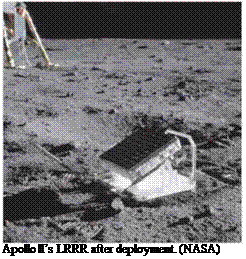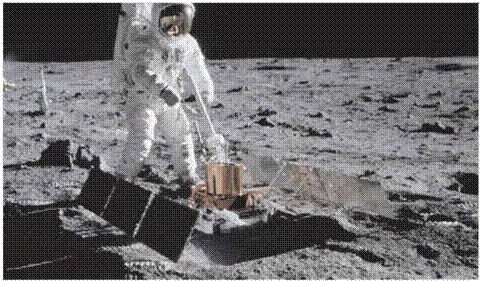In an effort to get around the terribly short period of time that an Apollo CSM was permitted to orbit the Moon, barely a w? eek at most, scientists added a small, 35.6- kilogram subsatellite to the SIM bays of Apollos 15 and 16. This was ejected just before the crew? headed home. Its function was to investigate the various particles and fields in the lunar environment. ‘Particles and fields’ is an expression used within the planetary science community for the investigation of planets and their environments whereby, rather than taking pictures of a planetary body, measure-
|
Apollo 15’s subsatellite about to be installed in the service module. (NASA)
|
ments are taken of the force fields, molecules and radiations that surround and interact with it. In the late 1990s, this work was continued by the Lunar Prospector probe.
The subsatellites added an extra complication to the missions’ flight plans because the scientists did not want them to be placed into the CSM’s normal orbit. Orbits around the Moon are inherently unstable. Given enough time, the influence of the mascons beneath the lunar surface and the tug of Earth’s gravity will cause an orbiting body to hit the surface. The subsatellite had no means of propulsion with which to compensate for these perturbations and if it were to be deployed from the CSM’s normal orbit, its lifetime would have been measured in weeks. But by manoeuvring the CSM prior to deployment it would be possible to extend its life towards a year.
“I have the Shape SPS/G&N PAD, when you’re ready for that,” said Joe Allen. He was ready to read up the details of the bum that would shape Apollo 15’s orbit in preparation for the subsatellite launch.
Jim Irwin usually took on the task of copying down the pads for this mission: "Okay, Joe. I’m ready on the Shape PAD.” Occurring only two and half hours before TEI, the manoeuvre required only a З-second bum of the SPS engine to raise their orbit’s apolune and perilune from 121.1 by 96.7-kilometre values to 140.9 by 100.6 kilometres respectively.
The shaping burn was made successfully just before Endeavour went behind the Moon for its penultimate lime. Then, around the far side. Worden executed ‘Verb 49′ in the computer, w’hich instructed it to bring the spacecraft’s attitude around to one that would place the long axis of the subsatellite perpendicular to the ecliptic and therefore perpendicular to the Sun. The launching mechanism was designed to spin the subsatellite as it was ejected from its receptacle in the SIM bay. This stabilised the small craft as it drifted aw-ay from the CSM. allowing the solar panels around its body to receive the sunlight required to power it. When they came back around the near side, the crew’ armed the pyrotechnics of the ejection mechanism while mission control monitored the spacecraft’s telemetry. An hour and 20 minutes before 1 HI, Allen piped up: "Endeavour. W’e verify your SIM pvro bus arm, and your rates look good to us down here. Over.”
"Okay,” replied David Scott. "We’ll go Free.”
As it w’as desirable for the spacecraft to be as still as possible for the deployment, time had been allowed for its rate of rotation to settle down within the half-degree dead band around the ideal launch attitude. Then, rather than risk the thrusters firing just as the subsalelliie departed, the control mode for attitude was switched to Free essentially disengaging the autopilot and allowing the spacecraft to drift. This w’as the first time that such a satellite ejection had occurred on a NASA spacecraft. "And wn know one of you will be watching out the window,” reminded Allen. "We’re particularly interested if the spin of the satellite is sweeping out a cone or if it seems to be a fairly flat spin as it comes out.” What Allen meant was that the satellite should be spinning around its long axis. It w’as important to the long-term future of the little spacecraft that this rotation be as even as possible as it departed.
However, there was still enough rotation in the CSM to take it slightly out of the desired attitude. ”Endeavour. we’re requesting you go back to Auto and do another ’Verb 49’. please. We see you drifted off about a degree.”
"In work," obliged Worden.
A suggestion then came from someone in mission control that the CSM should constantly correct its attitude until just before the launch. "Okay. Endeavour called Allen. “We’re recommending that you go back to Free at launch minus one minute."
"Okay; Free at launch minus one minute." confirmed Irwin. Mission control was still considering this one. Allen came on the air/ground a minute later with a revised procedure: "Endeavour, we’ve got a new update for the last instructions. Go Free at launch, please.”
Scott took a turn to reply: "Roger; Free at launch.”
By minimising the time spent Free they would reduce the scope for drifting off attitude.
Scott counted down the moments to launch: "Three, tw’O, one. Launch. We have a barber pole."
The subsatellite and its deployment mechanism moved along a track, opening a door in the process. It then engaged a switch that Tired the pyrotechnics to release it. allowing a spring to push it away from the spacecraft. A pin engaged in a curving
groove in a cylinder and imparted a rotation to the subsatellite which was stabilised by the deployment of three antennae. Scott saw a talkback indicator go to its ‘barber pole’ state. Once launch was complete, the deployment mechanism was retracted and this placed a grey flag in the indicator.
“And a grey,” confirmed Scott. “Tally Ho!”
“Can you see much?” asked Allen.
“Oh, looks like it might be oscillating maybe 10 degrees at the most,” said Scott as the long, hexagonal satellite drifted away, its three long, thin antennae sweeping out arcs in the sunlight. “A very pretty satellite out there. We get about two flashes per rev off each boom, and it seems to be rotating quite well. Very stable.”
The Apollo 15 subsatellite worked well for seven months before its telemetry failed. Apollo 16’s fared less well because mission control had decided to save the iffy SPS engine for the TEI manoeuvre and therefore cancelled the burn to shape their orbit. The subsatellite operated perfectly for 34 days before the changes in its orbit caused it to impact somewhere on the far side. The main result was a greater understanding of how the solar wind interacts with the Moon. In particular, the magnetometers on board each subsatellite also provided detailed information of the remanent magnetic field that some areas of the Moon exhibited in the form of miniature magnetospheres which warded off the solar wind.
Other tasks that had to be completed prior to the TEI bum on a J-mission included the retraction of instruments and paraphernalia that projected from the SIM bay. As the mapping camera was operated while extended out along a track to give the stellar camera a view to the side, the entire device was supposed to be retracted. However, this mechanism failed on Apollo 15. On Apollos 15 and 16, two instruments were operated on the end of 7-metre-long booms that could not withstand the load of an SPS engine bum. Although these booms were excluded from Apollo 17, it had two long antennae that projected out to either side of the service module, and these had also to be retracted. If any of these protuberances failed to retract, the crew had the option of jettisoning them, as was done when Apollo 16’s mass spectrometer boom failed.














